Running long jump were part of the pentathlon back in Ancient Greece. Historians cannot say exactly how the sport was played, but it is known that ancient athletes jumped with dumbbells in their hands, pushing off from hard ground, and landing on soft, loosened ground.
Long jump competitions began to be held with the beginning of the revival of athletics. In 1860, this species was included in the program of the annual " big games» Oxford University in England. The first recorded record was 5.95 m. In 1868, the Englishman A. Toswell jumped 6.40 m, and already in 1874, the Irishman D. Lane overcame the seven-meter line. His record is 7.05 m.
In 1935, the American athlete D. Owen jumped 8.13 m, this record lasted until 1960. In 1968, on Olympic Games in Mexico City, R-Beamon (USA) shows a phenomenal result - 8.90 m, which is still an Olympic record. Only in 1991, another American, M. Powell, brought the world record up to 8.95 m.
In women, world records begin to be recorded since 1928. The first record holder was the Japanese K. Hitomi - 5.98 m. The six-meter line was overcome in 1939 by the German jumper K. Schultz - 6.12 m. became the Soviet jumper V. Bardauskene, who showed results in 1978 - 7.07 and 7.09 m. Currently, the world record belongs to the Russian jumper G. Chistyakova - 7.52 m.
Running long jump technique has three varieties: “bending legs”, “bending”, “scissors”. The easiest way to "bend your legs" was used before late XIX V. The modern method of "scissors" first appeared in 1900, but became widespread only in the 30-40s. 20th century In 1920, the Finnish jumper Tuulos first demonstrated new technology long jump - "bending". Despite the fact that this method is less effective than the "scissors", many jumpers, and especially women, use it widely. A number of other jumpers use a combined technique of these two methods. The run-up long jump technique can be divided into four parts: run-up, take-off, flight and landing.


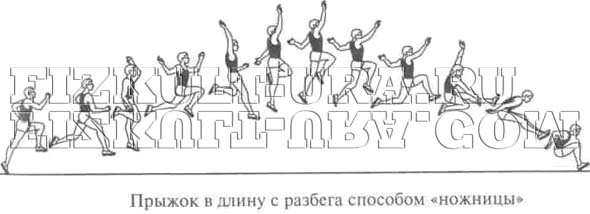
takeoff run. The run in the long jump is used to create the optimal speed of the jumper. The take-off speed in this form is closest to the maximum speed that an athlete can develop, unlike other types of jumps. The length of the run and the number of running steps depend on individual features athlete and his physical fitness. Leading athletes use up to 24 running steps with a take-off run of about 50 m. For women, these values are somewhat less - up to 22 running steps with a take-off run of over 40 m. repulsion.
Start of run may be different. Basically, athletes use the following options: from a place and from an approach (or run-up), as well as with a gradual increase in speed and a sharp (sprint) start. The start of the run is important, as it sets the tone and rhythm of the run. The athlete must be trained to standard start takeoff and do not change it without prior preparation.
At the start of the run from a place, the athlete starts moving from the control mark, placing one foot forward, the other behind on the toe. Some runners perform in this position a slight swing back and forth, moving the weight of the body to the front. standing foot, then on the back standing. When an athlete starts the run-up with a movement (approach or run-up), it is important that he accurately hits the control mark with a predetermined foot. It must be remembered that when even number of the running steps of the takeoff, the push leg is placed on the control mark and the movement begins with the fly leg and vice versa.
After the athlete has completed the start of the run, takeoff speed set. Here the jumper performs running steps similar in technique to running short distances in a straight line. The amplitude of movements of the arms and legs is somewhat wider, the inclination of the torso reaches 80°, gradually assuming a vertical position by the end of the run. At this moment, it is necessary to focus on elastic repulsion with each step, control your movements, run in one line without swinging to the sides.
IN preparation for repulsion on the last 3-4 running steps, the athlete must develop the optimal speed for himself. This part of the run is characterized by an increase in the frequency of movements, a slight decrease in the length of the running step, and a slight increase in the rise of the thigh when it moves forward and upward. The push leg, straightened at the knee joint, in the last step is placed in the place of repulsion with a “raking” movement back to the full foot.
The deviation of the shoulders back before repulsion is achieved by actively pushing the pelvis forward with the swing leg in the last step, which is shorter than the previous ones. It is not recommended to specifically bend it at the knee joint when setting the push leg, performing a squat. Under the influence of the take-off speed and gravity of the jumper, the leg itself will bend at the knee joint, and when stretching tense muscles, repulsion will be more effective.
Repulsion. This part of the jump starts from the moment the foot is placed at the place of repulsion. The foot is placed on the whole foot with an emphasis on the outer arch, some athletes put the foot from the heel. In both cases, some sliding of the foot forward by 2 - 5 cm is possible, this is especially observed when setting the foot from the heel, since there are no spikes on it and it can slide forward. This is also facilitated by the irrational setting of the pushing leg, located too far from the projection of the GCM.
The optimal angle of setting the push leg is about 70 °, the leg is slightly bent at the knee joint. Beginning jumpers and athletes with insufficient development of leg strength are not recommended to artificially bend the leg at the knee, as the jumper may not be able to cope with the support reaction forces acting on him. In the depreciation phase (from the moment the foot is placed on the support to the moment of the vertical), in the first fractions of a second, there is a sharp increase in the reaction forces of the support, then their rapid decrease occurs. Under the influence of these forces, flexion occurs in the knee and hip joints. From the moment of the vertical, when the swing leg is actively extended forward and upward, extension is performed in these joints. Until the moment of the vertical, there is a slight increase in the reaction forces of the support due to the work of the muscles and the inertial properties of the fly leg and arms.
The work of the muscles involved in the extension of the knee and hip joints begins even before the passage of the vertical moment, i.e. flexion in the joints has not yet ended, and the extensor muscles are already actively starting their work, effectively using the elastic forces of the muscle components. The movements of the fly leg and arm forward contribute to the transfer of the momentum of the masses of these links to the entire body of the jumper. Repulsion ends at the moment of separation of the foot from the support, while the reaction forces of the support are already negligible.
The purpose of repulsion is to convert part of the horizontal take-off speed into the vertical take-off speed of the body of the jumper, i.e. give the body initial velocity. The optimal repulsion angle is within 75°, and the optimal departure angle is within 22°. The faster the repulsion, the less loss horizontal take-off speed, which means that the range of the jumper will increase.
Flight. After the body of the jumper is separated from the place of repulsion, the flight phase begins, where all movements are subject to maintaining balance and creating optimal conditions for landing. The repulsion gives the GCM a trajectory of movement, which is determined by the value of the initial take-off velocity of the body of the jumper, the take-off angle and the take-off height. The world's leading jumpers reach an initial speed of approximately 9.4-9.8 m/s. The height of the rise of the GCM is approximately 50 - 70 cm. Conventionally, the flight phase of the jump can be divided into three parts: 1) takeoff, 2) horizontal forward movement and 3) preparation for landing.
Take-off in all jumping methods is basically the same. It represents flight in a step. After repulsion, the push leg remains almost straight behind for some time, the fly leg is bent at the hip joint to the level of the horizon, the lower leg is bent at the knee joint at a right angle with the thigh of the fly leg. The body is slightly inclined forward. The arm opposite the fly leg is slightly bent at the elbow joint and is in front at the level of the head, the other half-bent arm is laid back. Head held straight, shoulders relaxed. The opposite movements of the arms and legs with a fairly wide amplitude and freedom of movement compensate for the rotational moment around the vertical axis of the body after the repulsion is completed. Next, movements are performed that correspond to the style of the chosen jump.
The flight phase of the jump "bending legs" is the simplest, both in execution and in the study of technique. After taking off in the step position, the push leg is bent at the knee joint and brought to the fly leg, the shoulders are retracted somewhat back to maintain balance, as well as to relieve excessive tension in the abdominal muscles and the front surface of the thighs, which keep the legs in weight. Hands, slightly bent at the elbows, rise up. When the trajectory of the GCM begins to go down, the shoulders are sent forward, the arms go down in a forward and down movement, the legs approach the chest, straightening at the knee joints. The jumper assumes a landing position.
The jump in the "bending" way is more complicated and requires a certain coordination of movements in flight. After taking off and flying in a step, the fly leg drops down and back to the push leg. The hand in front goes down, joining the other hand; arms are straightened at the elbow joints; then, moving back, rise up. The jumper is in a bent position and, as it were, maintains a pause, overcoming in this position a little less than half of the flight phase. After both legs go forward, bending at the hip and knee joints, the shoulders lean slightly forward, the arms drop forward and down. In the final part of the flight, the legs are straightened at the knee joints, the arms are laid back. The jumper assumes a landing position.
The most difficult and most effective in terms of technique is the long jump using the “scissors” method. Its effectiveness is manifested by maintaining the coordinating structure of the running step in the transition from takeoff to repulsion and in movements in flight. More accurate name of this method "running through the air", since the jumper in flight performs 2.5 - 3.5 steps.
From the position of a step in flight (first step), the fly leg straightens down and goes down and back, the push leg is brought forward. Continuing the movement, the swing leg moves back, bends at the knee joint, and the push leg is carried forward with the thigh, bent at the knee joint (second step). After that, the fly leg, bent at the knee joint, is brought forward, joining the push leg. After both legs are straightened at the knee joints, taking a position before landing. Hands perform circular movements, through the sides. When the swing leg goes down, the opposite arm goes down and the other arm goes up. When the pushing leg is brought forward, the opposite arm is also brought forward, and the other arm back. When pulling the fly leg to the push leg, the arms go down and are retracted before landing.
Landing. This final part of the jump has great importance for its range. Preparation for landing begins in the last part of the flight, when the jumper's GCM descends to its height during repulsion. The jumper straightens the legs at the knee joints, the shoulders go forward, the arms, slightly bent at the elbow joints, are retracted as far back as possible. For effective landing, you need to hold your legs so that their longitudinal axis is under more acute angle to the landing surface.
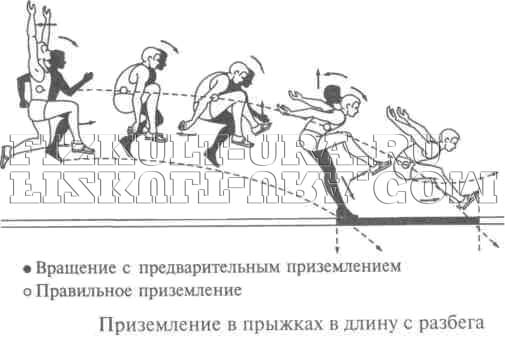
After the contact of the feet with the landing surface (sand), the jumper actively sends his arms forward, bending his legs at the knee joints and moving the GCM beyond the line of touching the sand with his feet. Some jumpers use side slip landings, i.e. after touching the sand with his feet, the jumper relaxes to a greater extent the leg in the direction of which he will make the exit, while actively helping himself with his hands and shoulders, a sharp turn is made in the direction of the exit. The turn is performed by moving through the back, i.e. back, while simultaneously bringing the other shoulder and arm forward. It must be remembered that bringing the arms forward prematurely will cause the legs to drop down and lead to an early contact with the landing site.
The increase in performance in long jumps from a running start depends on the strength of the legs, the speed of the take-off, the speed of repulsion and the coordination abilities of the jumper. An increase in the take-off speed by 1 m/s allowed our leading jumper I. Ter-Ovanesyan to improve the result by almost a meter.
List of used literature:
- Zhilkin A.I. etc. Athletics: Proc. allowance for students. higher ped. textbook institutions / A.I. Zhilkin, V.S. Kuzmin, E.V. Sidorchuk. - M.: Publishing Center "Academy", 2003. - 464 p.
Perhaps the desire to jump as far as possible has been characteristic of man since primitive times. It was then that the ability to overcome a wide cleft became the key to a successful hunt or a saved life. The ability to jump far can come in handy even now: during school or college competitions or to impress friends on vacation.
The main key to success in the long jump is a good run-up speed. So if you want to jump far, learn how to run fast.
Use interval training for this. Alternate running at an average pace with maximum accelerations. The run-up distance is not too long, so you won't need stamina.
But you will need a strong push. To learn how to push off well, learn to sharply push the body up. Stand on an exercise bench or stable platform. Bend your legs slightly at the knees. Swing with both hands and jump down. After landing, immediately jump up sharply. Stretch your whole body as high as possible and try to pull your knees to your chest. Perform these jumps for 5-8 minutes. Then rest 60 seconds and repeat.
When you realize that jumping with leg raises is easy for you, move on to a more difficult exercise. You will push off the platform with two feet, and land and jump with only one foot. In no case do not start jumping on one leg until you have mastered the previous load in full.
Plyometric exercises require excellent muscle and joint preparation. Otherwise, you are easily injured.
Include standing jumps in your workout. The main task of this exercise is to work out the correct movement of the hands. Also learn to stretch your legs forward while jumping and bend at the waist as much as possible. After the push, try to pull your knees to your chest, and in the last phase of the flight, fully straighten your legs.
Gradually combine the run-up, repulsion with one foot and the work of the hands. It is very important to fly not up, but forward. The ideal long jump occurs at an angle of approximately 20 degrees. Your task is to learn it.
Do not learn to long jump on a hard surface. Jumping technique involves landing on the buttocks. All training for long jumpers takes place in a special jump pit or even in a training pit filled with pieces of foam rubber. It is here that athletes practice the technique of bending the body and throwing the legs forward during the flight. Thanks to this, the jump lasts much longer.
Landing is also practiced here. As you know, the measurement of results in long jumps occurs from any touch point located closer to the push bar. In order for the hands not to remain behind, a strong take-off is needed. High speed allows the body to continue moving forward, although the legs and pelvis have already touched the ground.
Therefore, run as fast as possible, push the body forward powerful impetus, use your arms to provide additional momentum and pull your legs forward as you fly.
Standing long jump
Standing long jump - this is a complex, locomotor, acyclic, symmetrical movement associated with the repulsion of the body from the supporting surface, throwing it up and then landing. This type of jump is the simplest for anatomical analysis, although it is the main one, and all the others (with a triple run) are its varieties. A long jump from a place has four phases: the first is preparatory, the second is a push, the third is flight and the fourth is landing .. The movements during the jump are due to the interaction of external and internal forces. From external forces highest value have the force of gravity and the reaction force of the support, and the force of gravity acts throughout all phases of movement, and the reaction force of the support only in the first and fourth phases. O.c.t. body in this type of jump describes a parabola, the trajectory of which is the resultant of two forces: the force of the push and the force of gravity of the body. The force of the push during a long jump from a place should be directed approximately at an angle of 45 ° to the horizon (according to theoretical calculations in mechanics, since the movement of a body in the phase of free flight during jumps can be considered as the movement of any body thrown at an angle to the horizon). The area of support in different phases of the jump changes: in the preparatory phase it is the largest, as it is formed by the area of the plantar surface of the feet and the area of the plantar surface located between them; towards the end of the push phase, the support area decreases due to the fact that only anterior section feet; at the beginning of the last phase - the landing phase - the support area is also small, since the landing occurs only on the back of the foot, and by the end of this phase, the support area increases, since the jumper relies completely on both feet. In this regard, the degree of body stability in each supporting phase of the jump is not the same: in the first and last phases, the stability is greater than in the second phase. At the same time, backward stability is more pronounced in the first phase, and forward stability is more pronounced in the last. The work of the motor apparatus in the first phase is reduced to providing a posture and creating the most favorable conditions for repulsion. In order for the repulsion to be strong, Fr. c. so the body at the beginning of it should occupy the lowest position, and at the end - the highest. Besides, important condition, which increases the repulsion force, is the stretching of the leading muscles that carry it out. In the preparatory phase, the jumper's body is in a squat position. Under the influence of gravity, flexion in the hip and knee joints, extension of the feet occurs. torso Not how much it is tilted forward, the arms are unbent at the elbow joints and laid back, the belt of the upper limbs is lowered. This position is provided by the tension of the muscles, not of the same name as the movements in the joints, but by their antagonists. Thus, the hip extensors, leg extensors and foot flexors are tense on the lower limb. They perform inferior work and are in a stretched state. Parallel placed on the entire plantar surface of the foot increase muscle stretch. A heel tear reduces the area of support, worsens the conditions of balance and does not provide sufficient stretching of the muscles.Rice. Standing long jump. 12 consecutive body positions:
/ - preparatory phase; 2, 3, 4, 5, 6 - push; 7, 8, 9, 10 - flight in the air; 11, 12 - landing (orig.)
The trunk and head are held by the extensor muscles of the spinal column, which also perform inferior work and are in a stretched state. The position of the arms in the elbow joints is provided by the tension of the extensors of the forearm (triceps muscle of the shoulder), and in the shoulder - the extensors of the shoulder (deltoid, latissimus dorsi, subscapularis, etc.). The arms pulled back stretch the shoulder flexors ( pectoral muscles, two-headed, coraco-humeral). The squat position, the lowered belt of the upper extremities lowers about. c. t. of the body and stretch the muscles that provide subsequent repulsion. In the second phase, repulsion occurs simultaneously with both legs. The parallel arrangement of the feet provides a more uniform transfer of the repulsive force through the pelvis to the o.c.t. body and allows greater use of the muscles of the plantar surface of the feet. During repulsion, flexion in the ankle joint, extension in the knee and hip joints, straightening of the torso and a sharp swing of the straightened arms upwards occur, which contributes to an increase in the o.c.t. body. The lower limbs, torso and upper limbs form an almost straight line, and the repulsive force is transmitted along the bone base to the b.c.t. body. The leading muscles during repulsion are: foot flexors (muscles of the plantar surface of the foot, back and outer surfaces of the lower leg), extensors in the knee joint (quadriceps femoris), extensors in the hip joint (mainly the gluteus maximus muscle), extensor muscles of the spine (mainly the muscle , straightening the body), flexors in shoulder joint(pectoralis major and minor, anterior deltoid, coracobrachialis biceps brachii). All these muscles perform overcoming work. To transfer the repulsive force to the b.c.t. the body of the jumper must be fixed in all joints, therefore, although for a short period of time, along with the indicated muscles, their antagonists also tense. The flight phase is not passive, it is necessary to use the flight path to the maximum, to accept and maintain a certain position of the body, which would not only not interfere with movement, but also contribute to the subsequent landing. In the flight phase, the lower limbs are carried forward. To reduce their moment of inertia, flexion in the knee joints and extension of the feet occur, carried out by the corresponding muscle groups that perform the holding work. Bringing the legs forward is possible due to the tension of the hip flexor muscles (iliopsoas, rectus femoris, tailor and scallop). At the same time, the pelvis moves backward and somewhat downwards. At the same time, movements of the arms (first forward, then down) and flexion of the body occur. The movements of the arms are due to the sequential tension of the flexors and extensors of the shoulder. In the flexion of the body, mainly the abdominal muscles (the rectus and oblique abdominal muscles) take part.
Javelin-throwing
Another example of an acyclic movement is the javelin throw. Javelin throwing is a complex, locomotor, asymmetric, acyclic movement. In this movement, the following phases are distinguished: the phase of the initial position, the phase of preliminary actions and the phase of the final movement.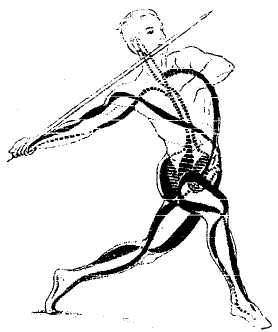
Rice. Home position phase
Home position phase characterized by the fact that the arm with the spear is raised up and bent at the elbow joint. The spear is located above the shoulder joint, the hand is approximately at the level of the auricle. This position is held by the flexor muscles of the hand and fingers (radial and ulnar flexors of the wrist, superficial and deep flexors of the fingers, long flexor of the finger, worm-like muscles), flexor muscles of the forearm (brachial, brachioradialis, biceps of the shoulder, pronator round) and muscles that remove shoulder (deltoid and supraspinatus). Phase of preliminary actions . The arm with the projectile is extended at the shoulder and elbow joints, the belt of the upper limbs is retracted, the body is turned in the direction of the spear movement, which is ensured by the work of the corresponding muscle groups. In this phase, the main weight falls on the opposite leg. It is extended at the hip and knee joints and bent at the ankle joint. The leg of the same name is bent at the knee joint, moved forward and placed on the supporting surface with the outer part of the foot (the thrower performs a “cross” step). Phase of the final movement . In this phase, the thrower performs extension of the leg of the same name in the hip and knee joints and flexion in the ankle joint. These movements are provided by contraction of the corresponding muscle groups. The main load falls on gluteal muscle, biceps femoris, semitendinosus, semimembranosus, adductor magnus, quadriceps femoris, triceps calf, tibialis posterior, extensor digitorum longus, and extensor longus thumb. These movements are joined by flexion of the trunk as a result of contraction of the iliopsoas, rectus abdominis, and external and internal oblique abdominal muscles. The girdle of the upper limbs moves forward with the torso. The thrower bends the arm with the spear at the shoulder joint. In the elbow joint, flexion first occurs, and then a sharp extension of the forearm. The final movement is the flexion of the brush. Muscle work is ballistic in nature.Back somersault from a place
Back somersault from a place - this is a complex, acyclic, rotational movement, in which the body is repulsed from the supporting surface, the flight with the rotation of the body and its subsequent landing. The body rotates around a free axis passing through about. c. t. in the transverse direction. It is possible to rotate the body around the sagittal axis (with a side somersault). In a somersault back from a place, four phases are distinguished: preparatory, push phase, flight phase, landing phase. The flight phase, in turn, is divided into takeoff, grouping, rotation and straightening of the body (ungrouping). A somersault back from a place is conditioned, like any movement of an athlete, by the interaction of external and internal forces. The direction of the repulsive force passes ahead of o. c. t. body so that between about. c. t. and the point of application of force forms a shoulder, in connection with which a moment of rotation arises. The force of gravity acts in all phases of movement, while the reaction force of the support - only in the first, second and fourth phases. The degree of stability of the body changes in the same way as when jumping. During landing, the same muscles work as in the preparatory phase: foot flexors, extensors in the knee and hip joints. They perform inferior work at the beginning of the phase, and overcoming work when moving from a squat to a vertical position. The reduction of shocks during landing is achieved due to the depreciation properties of the lower extremities (menisci, ligaments of the femoral head, etc.), their specific position (bent at the knee and hip joints), due to the inferior work of the muscles, torso tilt and soil deformation. As for the mechanism of external respiration, in the preparatory phase favorable conditions are created for exhalation, when pushing away (due to the swing of the arms up) - for inhalation, in flight, breathing is usually somewhat delayed, and upon landing, exhalation occurs. The jump contributes to the predominant development of the muscles of the lower extremities, consistency in work individual groups muscles and movement precision.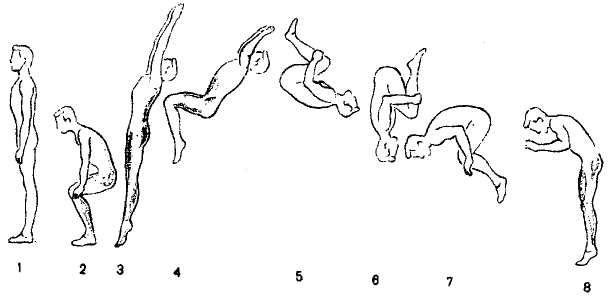
Rice. Back somersault: 1 - starting position, 2, 3 - repulsion phase, 4, 5, 6, 7 - flight phase,
8 - landing phase.
In the preparatory phase, the athlete squats. At this moment, under the influence of gravity (when viewed sequentially from the supporting surface), the links of the body in the joints are very specifically located. With a fixed foot, the lower leg is tilted forward, the angle between the foot and the lower leg is reduced, which is typical for foot extension. The knee joint is bent, but the thigh is close to the fixed lower leg, so that the angle between the lower leg and the thigh is reduced. The hip joint, like the knee, is in a state of flexion, however, it is not the hip that moves forward, as usual when bending the free leg, but the pelvis. The trunk is also in a state of flexion, the head is slightly tilted forward. This position is provided not by the muscles that produce these movements, but by their antagonists - the flexors of the foot, the extensors of the lower leg, the extensors of the thigh, torso and head. Moreover, they perform inferior work with distal support. The preparatory phase ensures the lowering of about. c. t. of the body and helps to stretch the muscles, preparing them for a stronger subsequent contraction in the repulsion phase. In the repulsion phase, there is a sharp flexion in the ankle, extension in the knee and hip joints, extension of the torso, head and swinging the arms up. The same muscle groups are tense as in the first phase, but they perform overcoming work. On a short time the antagonists of these muscles are also included in the work: the extensors of the foot, the flexors of the lower leg, thigh and spinal column, ensuring the creation of a rigid kinematic chain through which the repulsive force is transmitted. Raising the upper limbs is carried out due to movement in the shoulder joint and joints of the bones of the girdle of the upper limbs. At the same time, the shoulder flexors, working with the upper support, and the muscles that raise the belt of the upper limbs are tensed, and then (to fix the links of the upper limb) all the muscles surrounding the shoulder, elbow, wrist joints and joints of the hand are turned on. The upper limbs, moving the weight of the body upwards, raise the b.c.t. body to create an appropriate trajectory for it in flight. Since the moment of rotation of the body has arisen, it is necessary to arrange the parts of the body in such a way as to reduce the moment of inertia by increasing the angular velocity (according to the law of constancy of the moment of the number of movements). To do this, all points of the human body should be as close as possible to the axis of rotation. Therefore, in the flight phase, the so-called grouping is performed, in which the moment of inertia of the body decreases by about 2.5-3 times. The angular velocity increases by the same amount, which allows you to perform one or two; full turnover or body rotation. When grouping, flexion of the spinal column, flexion in the hip and knee joints, extension of the foot and flick head back (head jerk). The upper limbs descend, grab the shins and pull the legs towards the body. The movements of the spinal column, as well as movements in the joints of the lower extremities, are due to the tension of the corresponding muscle groups: the flexors of the spine, the flexors in the hip and knee joints, and the extensors of the foot, which first perform overcoming and then holding work. The jerk of the head is produced by the extensor muscles of the cervical spine and the muscles involved in the movement of the head backward, which are located on the back surface of the atlantooccipital and atlantoaxial joints. A jerk with the head, as it were, informs the body of an additional moment of the number of movements, which is transmitted to the lower part of the body, contributing to the acceleration of rotation. The lowering of the upper limb occurs predominantly; under the influence of gravity. The smoothness of movements is due to the inferior work of antagonists - the muscles that raise the belt of the upper limb. When gripping the shins, the flexors of the hand and fingers are tense. The bent position of the arm in the elbow joint is provided by the tension of the flexors of the forearm, working with proximal support. After rotation of the body to reduce the angular velocity, in accordance with the same law of constancy of the moment of the number of movements, ungrouping (straightening of the body) is performed - flexion of the foot, extension in the knee and hip joints, in the spinal column. With slow ungrouping, when the centrifugal force arising from rotational movements tends to remove individual parts of the body from the axis of rotation, the same muscles work as during grouping, but in a yielding mode. With rapid ungrouping, when centrifugal forces are not enough to move the body links away from the axis of rotation, these movements are performed due to the overcoming work of the antagonist muscles. The flexors of the foot, the extensors in the knee and hip joints, as well as the extensors of the spinal column are tensed
REPETITION AND SELF-CHECK QUESTIONS
- What does the term "dynamic anatomy" mean? What forces act on the body of an athlete in static positions and during movements? What is the general center of gravity of the human body and why is it determined? What types of body balance do you know? What determines the degree of stability of the body? Give a classification of the main movements of an athlete. Analyze the position and work of various parts of the athlete's body with proximal support. Analyze the position and work of various parts of the athlete's body during distal support. What movements are called cyclic? What phases of movements are distinguished in walking? What muscles work in each phase and what work do they do? What are the phases of crawl swimming on the chest? Give an anatomical description of each phase. What movements are called acyclic? Conduct an anatomical analysis of the standing long jump. What movements are called rotational?
Annex 1
(used when performing tests)

Leg stand apart
hands to the side

Handstand,
legs apart
knees together

Emphasis crouching on the right, left behind on the toe
Emphasis on your knees

Emphasis on the left knee,
right rear

Emphasis lying
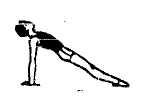
Emphasis lying behind

Emphasis lying sideways

Emphasis lying on the back of the forearms

Emphasis lying on the hips

Balance on one leg, leaning over
forward, other leg back, arms to the sides,
bent, hands behind the head
Lateral balance on one leg, the other to the side

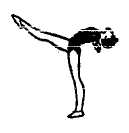
Rear balance on one leg, arms to the sides

Half twine
Rack on the shoulder blades
shoulder blade stand,
legs bent

Plow pose (toes touch the floor behind the head)

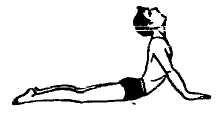
cobra pose

Bridge on the forearms
Lean forward
Leaning forward
Lean forward
with capture
squat on toes,
hands on the belt
Half squat,
hands forward

Squat on the left leg, right forward, arms forward
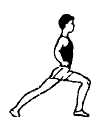
Lunge right
Handstand
kneeling
Rack on
left knee

Sed with straight
feet

Sed corner

Sit on heels
tilted
Sed bent over
Sit with a grip
Sit on heels
headstand,
legs bent
Headstand
Approximate diagram of the anatomical analysis of positions and movements
Anatomical full name student (s) __________________ analysis of the situation Group number ___________________________ Course ________________________________ Faculty ___________________________ Lecturer _______________________ Lean forward1. Description of the posture (indicate the position of the body, taking into account all parts of the spinal column, head, upper limbs, lower limbs)

Scheme 1 A Scheme 1 B 3. Acting forces (description of the direction active forces) ________________________________________________________________________________________________________________________________________________________________________________________________________________________________________________________________________________________________ Designate on diagrams 1 A and 1 B the vectors of acting forces 4. Position of the BCT ________________________________________________________________________________________________________________________________________________________________________________________________________________________________________________________________________________________________________________________________________________ Designate on the diagrams 1 A and 1 B the position of the BCT
Schematic representation with a projection onto the area of the support of the OCT
 _______________Scheme 2 ______________ Description of the area of support ________________________________________________________________________________________________________________________________________________________________________________________________________________________________________________________________________________________________________________________________________________________________________________________________________________________________________________________________________________________________________________________________________________
Stable Unstable Indifferent Justification of the type of equilibrium: ________________________________________________________________________________________________________________________________________________________________________________________________________________________________________________________________________________________________________________________________________________________________________________7. Degree of stability (shown on the diagrams the stability angles in two projections, their approximate value) Front angle - α Right angle - γ Back angle - β Left angle - λ
_______________Scheme 2 ______________ Description of the area of support ________________________________________________________________________________________________________________________________________________________________________________________________________________________________________________________________________________________________________________________________________________________________________________________________________________________________________________________________________________________________________________________________________________
Stable Unstable Indifferent Justification of the type of equilibrium: ________________________________________________________________________________________________________________________________________________________________________________________________________________________________________________________________________________________________________________________________________________________________________________7. Degree of stability (shown on the diagrams the stability angles in two projections, their approximate value) Front angle - α Right angle - γ Back angle - β Left angle - λ WITH  circuit 3 A circuit 3 B
circuit 3 A circuit 3 B
The ratio of stability angles (mark)
| α = | β | γ = | λ | ||||||
| α > | β | γ > | λ | ||||||
| α < | β | γ < | λ |
9. the position of the body links in the joints and the work of the muscles
| Joint name | The position of the links of the body in the joint | Support for muscles to work | Muscles that perform holding work |
Control work on individual task
GIVE ANATOMICAL ANALYSIS
Chapter: Gymnastics
- Failure and approach to the teacher. Opening with an added step to the left. Rebuilding from a column of one to a column of two. Carrying the gymnastic bridge together. Squat - hands forward. Jump in place with a change of legs (scissors). Jump on both (jump), hands arbitrarily. Rebuilding from one line to two. Translation of a gymnastic stick from a horizontal position to a vertical position and vice versa (starting position - arms extended, upper grip).
- Rope climbing without legs. From the hang with a wide grip, the transition to the hang on bent arms (crossbar behind the head). Rope jumping (on two, on one, with a change of legs). Bending and straightening of the arms in emphasis lying behind the hands on chairs. From a tilt, bending forward, legs apart, arms to the sides, turns of the torso (windmill). Movement in support from behind: a) feet forward; b) backwards. Lifting by force on the crossbar (through one arm). From the emphasis on the hands (bars) rise by kip.
Chapter: Athletics
- Low start (starting position standing). High start (starting position standing). Shot put from a place. Starting acceleration and transition to distance running. Transfer of relay. Start from prone position (obstacle course).
Chapter: Sport games
Basketball
- Player's stance. Passing the ball with both hands from the chest in place. Throwing the ball into the basket with one hand from the shoulder from the spot. Passing the ball with one hand from the shoulder. Passing the ball with both hands from the head. Throwing the ball around the ring with two hands from below (after moving forward). Passing the ball with one hand from below and from the side. Keeping the ball in place. Throw with two hands from the head in a jump.
Volleyball
- Top pass of the ball. Moving with side steps. Reception of the ball with two hands from below (after moving forward). Bottom straight feed. Top direct feed. Blocking an attack.
Football
- Hitting a stationary ball with the inside of the foot. Stopping a rolling ball with the inside of the foot. Hitting a stationary ball with the outside of the instep. Throw-in from the sideline. Heading the ball.
Chapter: ski training
- Alternate two-step move: repulsion with legs and sliding. Simultaneous two-step move. Turns on the spot by overstepping. Alternate two-step move: hand movements. Herringbone climb. Descent in a high stance. Climbing up the "ladder". Stepping up.
organization independent work when studying the topic
"Anatomical analysis of the positions and movements of the body"
I. The concept and scheme of anatomical analysis. II. General classification body positions. III. Characteristics of body positions:- Rack; Visas; Emphasis on parallel bars; Bridge.
- Walking. Run. Swimming.
- Standing long jump; Somersault back.
Literature
- Human anatomy / edited by V.I. Kozlova M., 1978 / Butin M.M. Skiing for faculties physical education M., 1983 and other literature on skiing Grachev M.S. Anatomy of the movement apparatus M., 1972 Ivanitsky M.F. Human Anatomy M., 1947 Ivanitsky M.F. Human Anatomy M., 1985 Athletics. Palyg's textbook. Gymnastics. Textbook for faculties of physical education M., FiS, 1980 Tailors. Sports Games M., 1976, 1981 Tvaladze G.M. Anatomical motion analysis human body M., 1969
Jumping is one of the oldest disciplines in athletics. High level training in this sport will also improve the technique of playing volleyball, tennis, parkour, etc. Often, athletes combine strength training with jumping in order to make classes more “multifaceted”, developing not only strength, but also flexibility, agility, and speed. Achieving results in jumps, both in length and in height, depends on the degree of preparation. In the first case, the main one is the maximum take-off speed, in the second - the repulsive force. The exercises are aimed at developing these skills.
Jump training program
Preparation for jumping training of both types is similar, so you should first bring the complex preparatory exercises, and then consider in detail the programs for high jumps and long jumps.
General training program:
- before any activity, it is imperative to do a warm-up and stretching for at least 5-7 minutes;
- squat - this develops the muscles of the legs, abdomen and back, makes the movements more “elastic”. Norm - 50-100 squats;
- jump rope - this strengthens the calf muscles, develops endurance. You should start with 100 jumps, gradually increasing the number to 400-500. Vary your speed, take breaks;
- run. useful not only for the muscles of the legs, but also for health in general. A 1.5-2 km run is an excellent preparation for an intense jumping workout.
long jump training
The main skills, as we have already said, in the long jump are the correct and strong repulsion, as well as the speed of the run. In addition to general exercises, trainers advise doing the following:
The benefits of jumping Even if you are not a professional athlete and do not strive to achieve high results, jumping can be very useful. According to coaches, they develop endurance, improve overall physical training have beneficial effects on health.
- run, lifting your hips high: 20 times on each leg slowly, then with average speed and finally, as fast as possible;
- train your hands - this is important for giving acceleration to the body. Starting position: standing, legs slightly bent. Perform intense swings with your arms, as if you were running. Do 2 sets of 25-30 seconds;
- do not neglect plyometric training. Perform several alternating sets: jumping onto a step, jumping off it, explosive jumps alternate with jumping for a distance. Follow the correct push;
- exercise with weights - for training the repulsion force, this is very effective method. Holding a bar from a barbell or a barbell (maximum 30 kg) on your shoulders, walk around the hall, paying particular attention to the fact that at the highest point of extension the push leg is fully extended, and the thigh of the fly leg is parallel to the floor during the step.
High jump training
To increase the height of the jump, first of all, it is important explosive force, therefore, the main exercises should be aimed precisely at its development:
- develop the ligaments and muscles of the legs with weighted squats. Holding a light barbell (15-20 kg) on your shoulders, do 2-3 sets of 15 repetitions;
- jump high on one leg. You can jump over obstacles. In this exercise, the main thing is that there is a person nearby who can insure you from falling. Do 2 sets of 15 repetitions on each leg, alternating them;
- do not forget about plyometrics - somersaults, explosive jumps, including from a hill with a soft landing, are very useful for jumping athletes;
- and most importantly, the high jump itself. Starting position: standing straight, feet shoulder-width apart. Squat down so that the angle between the hips and shins is 135 °, stretch your arms above your head, and then jump up sharply, reaching for your arms as much as possible. It is important that when performing the exercise, the muscles of the thighs are tensed more than the muscles of the legs.
After training, do a hitch with stretching - 7-10 minutes.
Be sure to make "control" jumps, write down the results - so you can follow the development of the skill.

What results can be achieved
Don't wait quick effect from training: as in any other discipline, planning and diligence are important in jumping. If for several months you regularly, at least 2-3 times a week, work hard, the result will be noticeable. You will jump further and higher. But overtraining should not be allowed - daily significant loads will give the opposite of the expected result - muscle pain and general weakness of the body.
As we have already said, a jumping training program must be carefully planned, and the load in it should be evenly distributed. If you are not a professional athlete, then "building" a set of exercises properly for you will be a difficult task. Therefore, it is better to contact an experienced trainer.
Fitness instructors are always ready to give you the necessary advice, help in drawing up a training plan, check the correctness of the exercises and adjust the program as needed.
The standing long jump technique involves the sequential execution of the following motor actions (phases):
Repulsion;
Landing.
Repulsion performed from the starting position: the legs are spaced to the width of the foot, the feet are parallel, the arms are along the body, the muscles are not tense. Rising on the toes, raise the arms forward and upward, then, descending on the heels, bend the legs at the knee joint (approximately 130-140 °), tilt the body down (keep the head straight) and transfer the weight of the body to the front of the feet (heels from the surface do not tear off) with simultaneous abduction of hands back to failure and slightly to the sides. After that, without stopping the translational movement, with a sharp wave of the arms forward and upward and active, powerful extension of the legs, first in the hip joint, then in the knee and ankle, perform repulsion. The repulsion time is minimal, without pauses, the departure angle is approximately 50-60 °. At the same time, the feet carry out a semblance of a raking movement from above and down - back in relation to the body.
Flight. In the flight phase, bend slightly and then with a sharp movement pull the legs to the body, then move them forward with the heels in readiness for landing, transfer the hands from the upper position to the middle position (at shoulder level).
Landing. Landing is carried out on both feet. It begins with the heels touching the surface. In this case, it is necessary to perform a roll from heels to toes without raising the latter too high, otherwise you may continue to move by inertia and not maintain balance. The legs are bent at the knee and hip joints to a squat position, the arms are extended forward (at shoulder level) or slightly down, which allows you to maintain balance after landing. You are allowed to touch the surface in front of you with your hands.
The sequence of teaching the technique of the long jump from a place.
Exercises for initial training.
Exercise 1. Rising on the toes, raise the arms forward and upward, then, sinking on the heels, bend the legs at the knee joint, tilt the torso down and transfer the weight of the body to the front of the feet (do not tear the heels off the surface), take the arms back to failure and slightly to the sides.
Exercise 2. Jumping up with raising arms forward and upward and landing on bent legs, arms in front of you, as when landing.
Exercise 3 Jumping up with raising arms forward-up and landing on bent legs with a slight advance forward (approximately 1-1.5 steps), arms forward or slightly down.
Exercise 4 Perform a short jump (taking into account the capabilities of the trainees), combining all previous movements into a single whole.
Exercise 5 Perform a jump to the mark indicated by the teacher, commensurate with the force of the push with the distance to the mark (take into account the capabilities of the trainees).
Exercise 6 Multi-jumping on two legs with the movement of the arms as if taking off.
Exercise 7 Performing a jump in general on the technique and at a distance of 70-80% of the maximum.
Improvement exercises.
Exercise 1. Performing backward jumps.
Exercise 2. Jumping up, overcoming the resistance of a partner who holds the shoulders and is behind.
Exercise 3 The same, but the partner holds the waist.
Exercise 4 Jumping over a small obstacle.
Exercise 5 The same, but with different burdens.
Exercise 6 Jumping to the maximum distance.
Upon completion of training in the technique of jumping and their improvement, exercises of a game and competitive nature are performed, some of which are presented in the fourth chapter of this manual.









